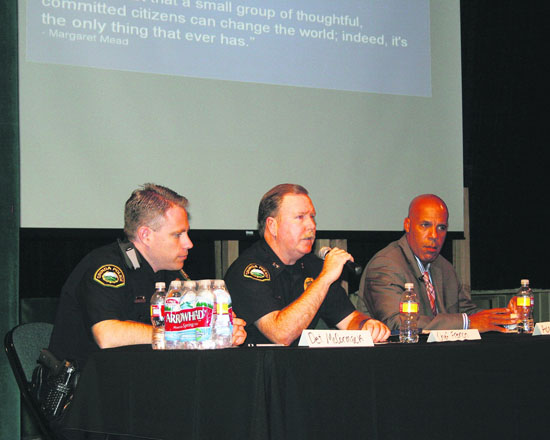
| ||||||
Principal Adam Clark started the evening round table by outlining the challenges facing the school administration with respect to underage drinking and drug use. He explained that any student caught on campus or attending a school-sponsored event under the influence of, possessing, using, or selling alcohol or drugs faces suspension, possible expulsion, and alternative placement. In every case, both the parents and police are contacted. "When students are caught violating the rules pertaining to drugs and alcohol at school or school sponsored events, the consequences are clear and punishment is easily applied," says Clark.
The challenge for the administration comes when students violate the rules prohibiting alcohol and drug use at parties on the weekend at private homes or other non-school sponsored events, according to Clark. He acknowledged that he had received feedback from the community that Miramonte was not holding athletes accountable for violations of the school's alcohol and drug guidelines. Clark explained that allegations of student alcohol or drug use are fully investigated, and the school's policy is uniformly applied. "If students are cited by the police [for illegal drug or alcohol use outside of school] that information can not be given to the school due to laws protecting minors," stated Clark. He reiterated that it is difficult to enforce school policy when students are drinking or using drugs at home, at a friend's home, or in a car. "Enforcement of the [administration's] policy can not be applied when we receive secondhand information, anonymous letters and phone calls," he added. 'We hear a lot of things. We have to be able to prove things."
The message from the Orinda Police Department (OPD) was one of zero tolerance. "Our process is to arrest underage drinkers and drug users and cite-release them to parent custody," said OPD Chief Bill French. While the police have the discretion to handle underage alcohol use in-house to provide first-time offenders a second chance-a process called diversion, the OPD does not practice diversion according to French. "These cases are too serious," he said. "I don't divert these cases. They go to juvenile court."
Chief French shared that there have been six arrests of minors (under age 18 years) for driving under the influence in Orinda between January and October of this year. Each year, approximately 15 young people are arrested in Orinda for alcohol related crimes (drunk in public, possession, furnishing), and this number has been consistent over the past few years. But these statistics do not provide a complete picture of youth alcohol use in Orinda, as Chief French pointed out, many young people are never caught.
Tedd Cassman, an Orinda resident and criminal attorney, explained that underage drinking is a misdemeanor with a possible fine of $200 to $500 and a mandatory one year driver's license suspension. "That hits them where it hurts," said Cassman, and that is one of the facts he emphasizes when he speaks to Miramonte seniors each spring. "If you are convicted of underage alcohol use, it does not have to occur in a car. You still lose your license," stated Cassman. A minor's driver's license is also suspended for the use of a fake ID and with any drug offense.
Dr. Jan Gurley's presentation about the physical consequences of alcohol intoxication in young people was-sobering. "You can not determine if a kid is safe based on the amount they drink," said Gurley, noting that there are a number of factors that impact an individual's response to alcohol. Her take-home message was to teach and encourage kids to get help when they see other kids drinking out of control. "It comes down to assertiveness training," said Gurley, who recommended giving kids a script for how to handle these situations. "Kids need to feel empowered to act."
Emily Justice from the Center for Human Development stated that while the incidence of underage drinking in the area has not risen dramatically in recent years, Contra Costa County carries the distinction of surpassing the State average. While the overall incidence has not risen notes Justice, there is evidence that the rates at which kids drink has increased dramatically-binge drinking is on the rise. She advocates the power parents hold to promote positive messages with their teens.
What more can be done to keep teens safe and drug and alcohol free was the closing question of the evening. Working with the community to change the culture surrounding alcohol use, providing young people with exit strategies to save face in situations involving underage alcohol use, and displaying positive role modeling as parents were some of the ideas outlined. All the panel members agreed that ongoing dialogue between kids, parents, school administrators, the police, and community members is essential to addressing the issue.
Reach the reporter at:
Copyright
